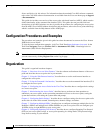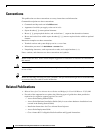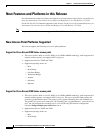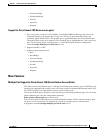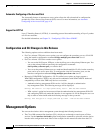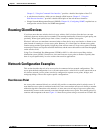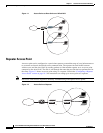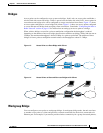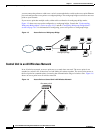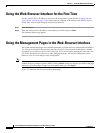
1-3
Cisco IOS Software Configuration Guide for Cisco Aironet Access Points
OL-30644-01
Chapter 1 Overview of Access Point Features
New Features and Platforms in this Release
–
Non Root Bridge
–
Workgroup Bridge
–
Scanner
–
Spectrum
–
Repeater
Support for Cisco Aironet 1700 Series access point
• This access point is built on 3x4:3(2.4GHz), 4x4:3(5GHz) MIMO technology, and comes with
integrated antennas, and supports 802.11a,b,g,n,ac. This access point has both primary and
secondary gigabit Ethernet ports. The primary port is gigabit Ethernet 0 and is the backhaul port.
The primary port can be set as trunk port. The secondary port is gigabitEthernet 1, and is the access
port. You can configure the secondary port to a VLAN ID using the interface configuration
command bridge multiple-port client-vlan vlan-id
• Supported model is 1700I
• Supported operating modes are:
–
Root
–
Root Bridge
–
Non Root Bridge
–
Workgroup Bridge
–
Scanner
–
Spectrum
–
Repeater
New Features
Multiple Port Support for Cisco Aironet 1550 Series Outdoor Access Points
The 1550 series has four Ethernet ports – PoE-In port, PoE-Out port, Auxiliary port, and SFP Port. All
four ports are supported in the current release. This series also has an internal cable modem in the 1552C
and 1552CU models. The cable modem connects to the Auxiliary port.
You can set the PoE-In port, SFP port, or the Auxiliary port as the primary Ethernet port. You can set the
primary Ethernet port using the configuration command:
dot11 primary-ethernet-port port-number-0to3
You can set the primary Ethernet port as a trunk and handle multiple VLANs, but the secondary ports
can be set as access ports only. To configure the vlan-id in secondary ports, use the interface
configuration command bridge multiple-port client-vlan vlan-id




